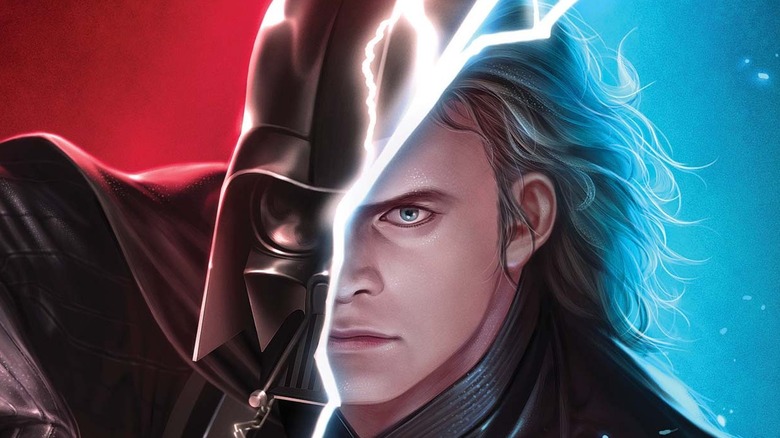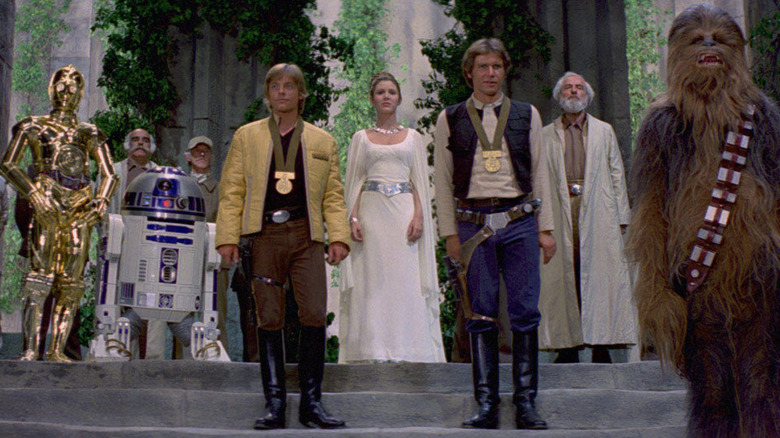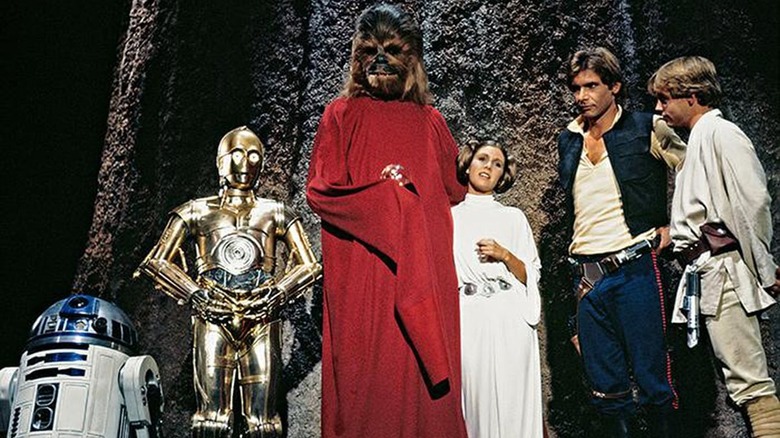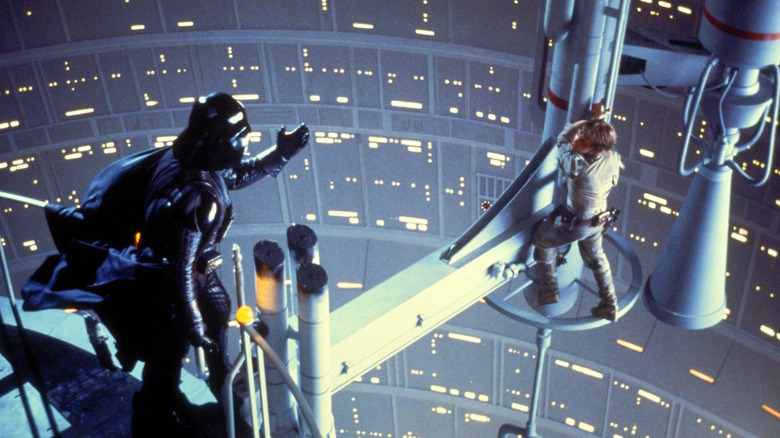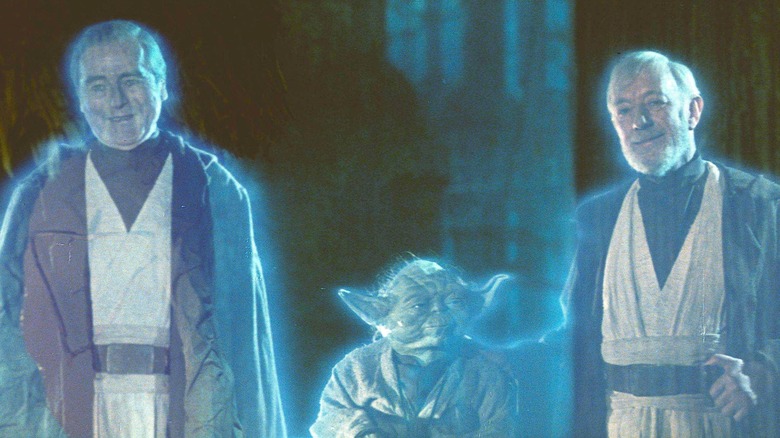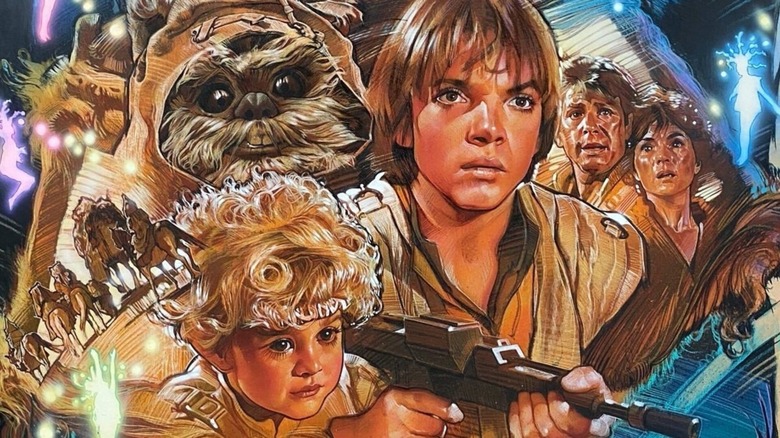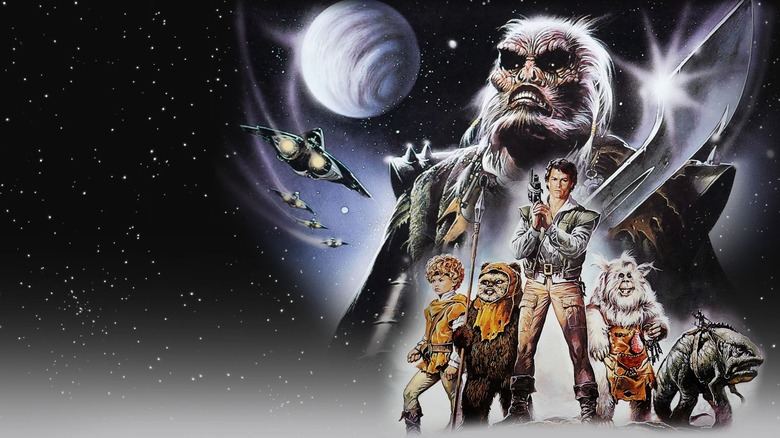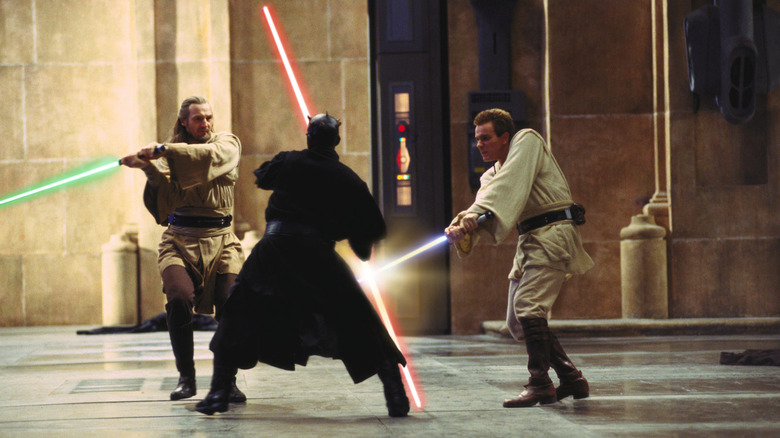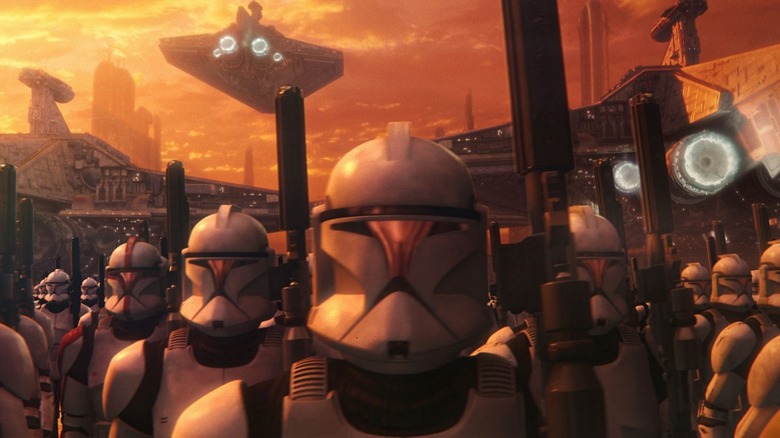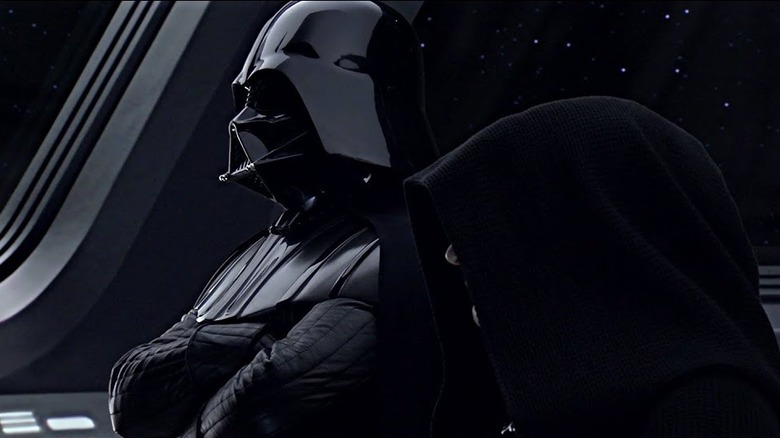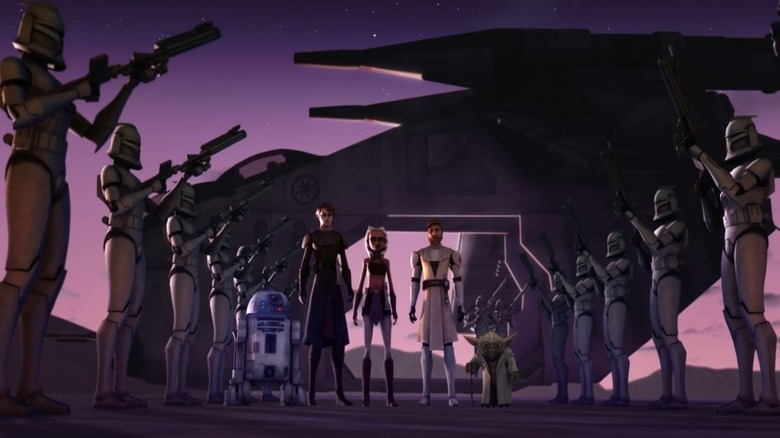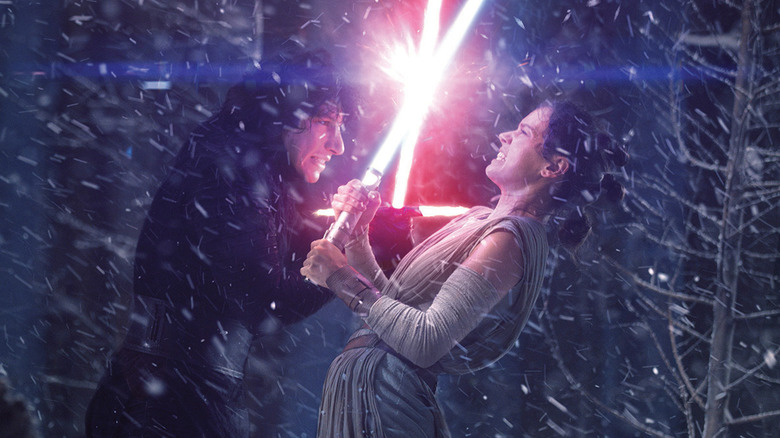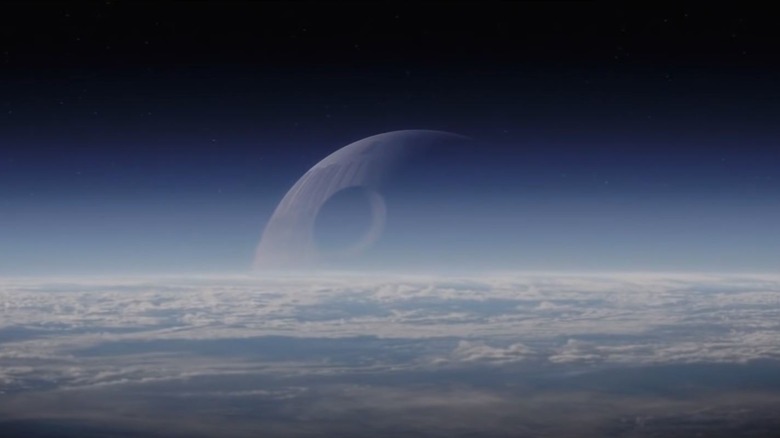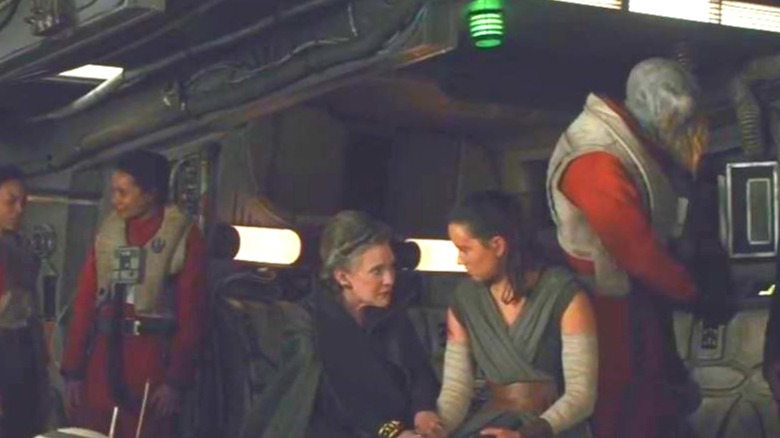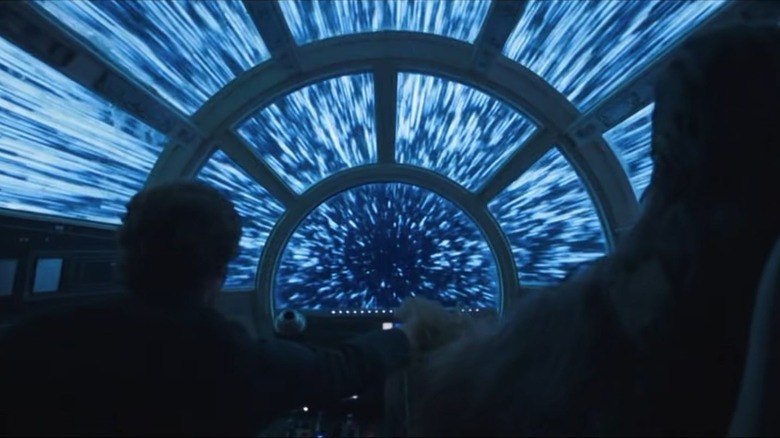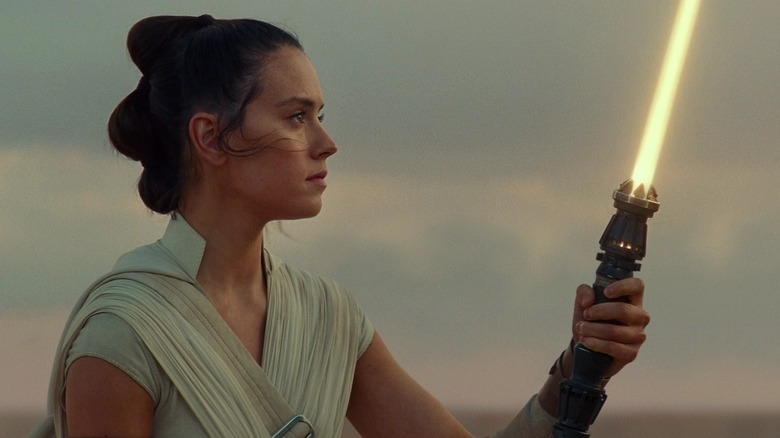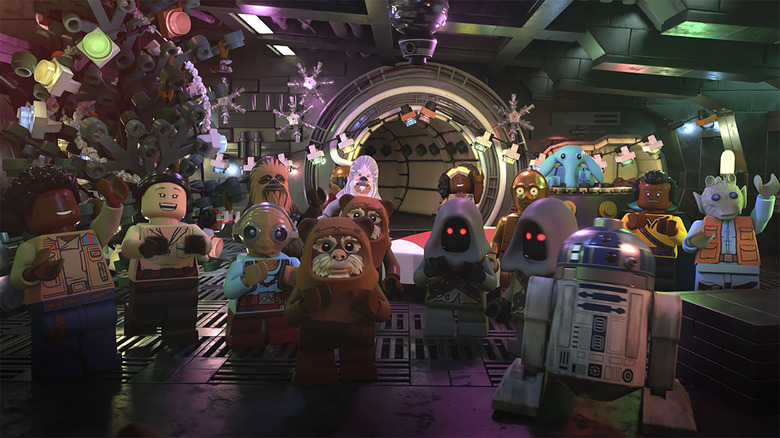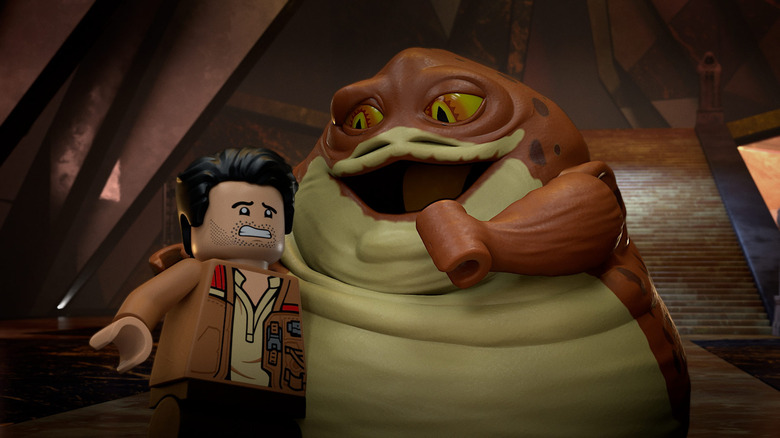The Ending Of Every Star Wars Movie Explained
Between the main, nine-chapter-long "Skywalker Saga," the franchise's spin-off "anthology films," and its surprising amount of one-off and television specials, "Star Wars" has a seriously daunting amount of films for newcomers to the universe. If the sheer number of them isn't bad enough, new viewers also have to deal with the fact that the films weren't released in chronological order and vary wildly in both quality and canonicity. Not every film "counts" anymore, and that's a concept that can be confusing or easy to miss for those unfamiliar with these stories.
Each film is a captured moment in time that influences every piece after it through to the present day and beyond. And while individual guides to each film are helpful tools that can provide in-depth information and analysis to its readers, an overview of every film, the endings, and their impact on the story and franchise overall can track the ever-growing narrative of the "Star Wars" universe as it developed over time. From its classic hits to its bizarre failures that are obscure for a reason, here is the ending of every "Star Wars" movie explained.
Star Wars: Episode IV — A New Hope
After escaping the Death Star, the ragtag group of heroes successfully delivered its schematics to the Rebel Alliance, but it came at a cost: the Empire found them and brought the very station the Rebels hoped to destroy. It was a mad race to see who could destroy the other first, but because two key characters fulfilled their personal arcs, the Rebellion won the day in "A New Hope."
Apart from Chewbacca, Han Solo had spent his life living up to his last name. He was in it for himself and had no interest in anybody who wasn't paying him, but after meeting Luke and Ben Skywalker and helping them reach the Rebel base, he found he couldn't keep looking the other way. He returned at the perfect moment, taking Darth Vader out of the fight and giving Skywalker the chance he needed to save the day.
Luke, meanwhile, had to learn to embrace the spiritual world of the Force and ease his ties to the physical world he's known all his life, and once he did that, he was able to make the impossible shot and destroy the Death Star. Han Solo's daring return showed that this scoundrel could become a hero, and Luke proved that he had what it took to become a Jedi someday. Darth Vader and the Empire were still out there, but the Rebellion had shown the entire galaxy that they could fight back.
The Star Wars Holiday Special
Audiences would have to wait a little while for a sequel to "A New Hope," as Lucasfilm first chose to make "The Star Wars Holiday Special." Released in 1978, just over a year after its predecessor, this was fans' first chance to return to a galaxy far, far away, and it was a doozy. A two-hour made-for-television variety special, the "film" followed Chewbacca's family of Wookies as he and Han Solo tried to make it home in time for Life Day.
The work's narrative largely revolves around the various strange, psychedelic, and sometimes disturbing entertainment these three furry aliens engage with as they wait for the Millennium Falcon's arrival. Chewbacca's wife Mala watches a cooking show to help her make dinner while calling various "Star Wars" characters for updates. Their son watches various shows and cartoons, and Chewie's father, Itchy, views some adult-rated material. All of this is inexplicably intermixed with brief returns to the Tatooine cantina.
Most of the special follows the various ways the furry family passes the time waiting for Chewie's return, and most of its cameos come from the Wookie's wife, Mala, as she calls her husband's friends and asks about his whereabouts. They all assure her that he's on his way there, and unfortunately, the Empire is convinced of the very same thing and hopes to use the holiday to capture Han and Chewbacca.
Imperial Stormtroopers search the Wookie's house and leave a soldier to wait for the rebels' arrival. But with the help of a local trader sympathetic to the Rebel cause, they manage to kill the soldier and file a false report that the Stormtrooper robbed the household and the trader before going AWOL with the stolen goods, forcing the remaining troopers to waste time looking for them.
With the Imperial soldiers out of the way, the Wookie family takes crystal orbs that look sort of like snow globes, lift them over their heads, and somehow use them to spiritually connect with the main cast and many other Wookies. They stand around the "Tree of Life" in red robes while Leia sings a strange, strange song. Then everybody leaves, and the special finally ends.
Star Wars: Episode V — The Empire Strikes Back
What "A New Hope" built up, "The Empire Strikes Back" would seemingly change forever. The victory against the Death Star now three years behind them, the Rebellion is on the back foot as Darth Vader destroys their base on Hoth. Though the majority of the Rebel fleet manages to escape, the crew of the Millennium Falcon spends the rest of the film failing to do the same while Luke trains on the planet Dagobah with Master Yoda.
With his new teacher and abilities, Luke once again has to embrace his growing connection to the Force and let go of his attachments. This time, however, the attachments that Luke has to discard are his friends, who have been captured by Imperials in Cloud City. Luke refuses to abandon them, but ultimately, his decision nearly gets them killed.
Han is frozen by carbonite and given to Boba Fett to be taken to Jabba's palace, while Vader uses Luke's friends to lure the boy into a trap to deliver him to the Emperor. Luckily, Lando betrays Vader and helps the rebels successfully flee Cloud City amidst its evacuation. They leave the city in the Falcon and are ready to leave the system when Leia senses that Luke is in danger. If he had not gone to them, they would have escaped then and there.
Luke paid a heavy price for his decision. He discovered that Vader was his father, lost both his hand and his lightsaber, and places all of his friends in the very danger he had hoped to save them from. By the time the credits roll, the heroes are still on the run, and their team is a man down. Though the Rebel fleet has started to regroup, they have no base and must lick their wounds with the Empire still nipping at their heels.
Star Wars: Episode VI — Return of the Jedi
While "The Empire Strikes Back" may have been the Rebellion's darkest day, "Return of the Jedi" proved to be one of its brightest. After freeing Han Solo from Jabba the Hutt, Luke Skywalker and the Rebel Alliance discover two things: Leia Organa is his sister, and the Empire created a second Death Star above the forest moon of Endor.
The rebels create a plan to take out the Death Star's shield generators while the Rebel Fleet engages the station in orbit, but it goes horribly wrong. Palpatine had let the Rebellion discover the super laser's existence to draw them into a trap, and he now had everybody right where he wanted them. Unfortunately, the Emperor had miscalculated.
He was wrong to believe that he could convince Luke Skywalker to join the dark side of the Force, and instead, Luke — having learned his lesson at last — restrained his emotions, let go of his anger, and spared his father. Rejected, Palpatine attempted to kill Luke, but he'd also failed to realize that Vader's love for his son would ultimately doom him. He also did not foresee that with the Ewoks' help, the Rebel assault on the shield generator would succeed, and his new station would be destroyed.
Han and Leia solidified their relationship, and the entire galaxy celebrated their freedom as Luke saw that his father had been able to join Ben and Yoda in the Force. Palpatine had miscalculated, and because of that, his Empire was over, and the dream of restoring both the Jedi and the Republic finally seemed within reach.
Caravan of Courage: An Ewok Adventure
A year after "Return of the Jedi," George Lucas experimented with television once more and released a made-for-television movie called "Caravan of Courage: An Ewok Adventure" on ABC. Starring the recognizable Ewoks of Endor, the story follows the Towani family after they crash-land on the forest moon and attempt to survive. The parents end up kidnapped by the Gorax, forcing their children — Cindel and Mace — to work together with Wicket and the Ewoks to rescue them.
After a long journey across deserts, acid pools, and giant mountains, the children overcome their fear, reach the Gorax's fortress, fight giant spiders, and — with the help of the fairy-like Wisties — free their parents. Ultimately, Gorax is defeated in the ensuing battle by essentially tripping him into a giant chasm, and the victorious heroes return to the Ewok village to celebrate their victory and mourn those they lost.
Ewoks: The Battle for Endor
In 1985, fans got their third Star Wars film in just as many years when another spin-off named "Ewoks: The Battle for Endor" aired on ABC. The sequel to "Caravan of Courage," this odd, strangely horrific movie can be seen under the "Star Wars: Vintage" banner on Disney+.
While repairing their ship after defeating the Gorax, a band of space marauders led by a Nightsister of Dathomir attack the village, enslave its inhabitants, and kill every member of the Tawani family except for Cindel, who manages to escape with Wicket and hide with an old hermit. The hermit, the marauders, and the Towani family had all crash-landed on the forest moon, and now they were competing for the parts they needed to repair their respective ships and leave.
After the Nightsister kidnaps Cindel, the hermit, Noa, and Wicket manage to infiltrate the castle, free the Ewoks, steal the parts, and use them to repair Noa's ships and defeat the marauders with its defenses. With the Ewoks free and the threat finally over, Cindel goes with Noa so that she can return to the galaxy at large, as Endor is not her true home.
Star Wars: Episode I — The Phantom Menace
When it finally hit theaters in 1999, "The Phantom Menace" was the first Star Wars film in over a decade. Armed with state-of-the-art CGI that was simply impossible when he finished the last film, George Lucas sought to finally finish his six-part saga by revealing the story of Anakin Skywalker and the Clone Wars that he had teased all the way back in 1977.
Ultimately, however, the story is the first part of Palpatine's complicated multi-stage coup of the Galactic Republic. By forcing the Trade Federation to invade Naboo using his Darth Sidious identity, Palpatine is able to convince the planet's Queen Amidala to declare a vote of no confidence in the Republic's current Supreme Chancellor Valorum, allowing Palpatine to replace him.
This act sets up the entire prequel trilogy and is the first step towards the Republic's ultimate downfall, turning most of the film's action sequences into the smokescreen behind which Palpatine rises to power. The initial invasion, the escape to Tatooine and its ensuing pod race, and even the final Battle of Naboo and the death of Qui-Gon Jinn are all just the distraction that allows Sidious' sleight of hand trick to succeed.
In the end, however, the entire saga comes down to one impressive Duel of the Fates between Qui-Gon, Obi-Wan, and Darth Maul. If Qui-Gon survived, his experience and outlook as both a Jedi and a teacher may have been enough to keep Anakin from falling to the dark side later on. But because Maul struck him down before being defeated himself, Obi-Wan is forced to train and ultimately fail the young boy.
Star Wars: Episode II — Attack of the Clones
"Begun, the Clone War has." "Attack of the Clones" was the moment that many fans had been waiting for since 1977. In order to fully transition the Republic into his own personal Empire, Darth Sidious needed a galaxy-wide crisis he could control and escalate over time. To that end, he had his new Sith apprentice, the former Jedi Master Count Dooku, organize a large secession from the Republic that the galaxy could only hope to stop by going to war.
To combat that "threat," Sidious had the Kaminoan clone masters create a Grand Army of the Republic from the genetic code of the most famous bounty hunter in the galaxy: the Mandalorian Jango Fett. This way, when the Separatists' massive droid army was revealed, the Republic would have no choice but to embrace this new clone army in order to fight back, beginning an endlessly-escalating conflict of constantly replaceable soldiers that Palpatine could use to slowly grant himself more and more powers in the Senate. The end goal, of course, is safely declaring himself Emperor after "winning" the war.
If that wasn't enough, Palpatine had also recognized the incredible power within Anakin and begun grooming him to be his future apprentice and most powerful weapon. He became the boy's friend in the decade between the two films and used that connection to subtly encourage Skywalker to embrace the dark side and act on it as he does with the Tusken Raiders.
It's an incredible, sinister feat of political engineering that would prove very successful. And oh yeah, there was also a bunch of lightsaber fights, a secret marriage, the first battle of some war, and the birth of a future bounty hunter named Boba Fett. Yoda apparently turned into CGI and jumped around a lot, too. Those things were fine, but the politics are where it's really at.
Star Wars: Episode III — Revenge of the Sith
From the moment the prequel trilogy was originally announced, fans of the original films knew how it had to end. In "A New Hope," there's no such thing as a Republic — Anakin is now Darth Vader, Palpatine is the Emperor, and the Jedi have been gone for so long that they're basically a myth. After two films of set up, "Revenge of the Sith" was the tragic moment where it would all come together.
Having used the Clone Wars to slowly but surely grant him near-total control of the entire Republic, Palpatine finally decides that he's ready to finish his master plan. Through careful arrangements, he plans for his future apprentice, Anakin, to fight and kill Count Dooku, pushing him close enough to the dark side that the fear of losing his wife is enough to send him sprinting over the edge. And with the Republic's final defeat of General Grievous and the droid army, Sidious finally pulls the ace out of his sleeve and executes Order 66, forcing every clone to rebel against their Jedi generals and kill them.
Obi-Wan and Yoda are some of the only survivors, and after discovering that Skywalker murdered younglings, Obi-Wan confronts Anakin on Mustafar and delivers a nearly-fatal blow that forces him to become the walking cyborg fans loved in Lucas' original trilogy. Having accidentally killed his wife, Padmé, before the fight, Anakin's transformation into Darth Vader is complete, and Palpatine crowns himself Emperor.
Star Wars: The Clone Wars
The prequel trilogy would find its own spin-off film in the 2008 animated film, "Star Wars: The Clone Wars." Set in-between "Attack of the Clones" and "Revenge of the Sith," this theatrically-released film was essentially the pilot project for the television series and helped fill in the gaps between the two movies.
The film introduced Anakin's own Padawan learner, a young woman named Ahsoka Tano, who would go on to become a fan-favorite character during the series. With the help of Clone Captain Rex and his soldiers, Obi-Wan, Anakin, and Ahsoka go on a mission to rescue Jabba the Hutt's son in exchange for the space gangster's support in the war. Unknown to these heroes, however, Dooku arranged the huttlet's kidnapping so he could frame the crime on the Republic and keep them from getting Jabba's aid.
By telling Anakin that Ahoksa was Jabba's prisoner when she wasn't even there, Dooku tried to trick Anakin into attacking the Hutt and ruin the Republic's chances to negotiate a treaty. Thankfully, Anakin managed to rein in his anger just long enough for Ahsoka to arrive with the baby and for Padmé to call in and reveal the role that Ziro, Jabba's uncle, had played in the kidnapping of the crime lord's son. With the Separatist treachery revealed and his son safe, the film ends with Yoda and the other three Jedi arriving on Tatooine to officially negotiate the treaty with Jabba and get his help in the Clone Wars.
Star Wars: Episode VII — The Force Awakens
A decade after the prequel trilogy concluded, Disney released "Star Wars: Episode VII: The Force Awakens" after purchasing the franchise from George Lucas for $4 billion dollars.
When a new empire arrives on the desert planet of Jakku in search of a secret map to Luke Skywalker, a desert orphan named Rey finds herself wrapped up in the Resistance's efforts to oppose the First Order's tyranny. She's given the classic Skywalker saber and told she can use the force but doesn't manage to receive much training before finding herself needing to destroy another planet-killing super-weapon.
Rey gets captured by Kylo Ren — Leia and Han's mostly evil son — and held on Starkiller Base, the newest iteration of the Death Star. Han, Chewie, and Finn fly to the base and attempt to rescue her before General Leia Organa and the Resistance can destroy the base with them still on it. After rescuing Rey, Han tries to reach his son one last time, but, determined to follow the path of his grandfather, Darth Vader, Kylo rejects his father's plea and murders him.
Chewbacca shoots Kylo in the gut with his bowcaster in a rage, and it's this life-threatening wound that allows Finn and Rey to survive a lightsaber fight with Ren long enough to escape the planet on the Millenium Falcon. By the film's end, Starkiller Base has been destroyed, Finn is rushed off to receive medical treatment for the wound he received during the saber fight, and Rey and Leia mourn Han's death. The Resistance fleet is on the run, and the New Republic is dead, but when BB-8 finally meets R2-D2, the small droid manages to reactivate the famous "Star Wars" character and complete the map, revealing Luke Skywalker's location and allowing Rey to seek him out for Jedi training.
Rogue One
The first of Disney's anthology films, "Rogue One: A Star Wars Story" promised to show how the Rebellion managed to get the Death Star plans that Princess Leia hid away in R2-D2 during "A New Hope." To that end, it largely followed a young woman named Jyn — the daughter of the Death Star's designer Galen Erso — as the Rebellion attempts to use her to find him. During this quest, fans see the shady, dark sides of the Rebellion and discover that the strange exhaust port weakness in the Empire's favorite superweapon was actually placed there on purpose by Galen so that the monstrosity could be defeated.
In doing so, however, they discover that the Death Star is already fully operational when it destroys Jedha City, and this knowledge sends the Rebellion into a panic. They believe that they can't possibly stand up to a weapon of that magnitude and elect to give up, despite Jyn's protests. However, Cassian Andor — haunted at the idea that the horrible things he had done in the name of the Rebellion might have ultimately been for nothing — also refuses to give up and agrees to follow Jyn into battle.
The plans are on the planet Scarif, so Jyn and Cassian Andor lead their team to assault the planet and beam the plans to a Rebel ship in orbit. Though they succeed, thanks to the timely arrival of Admiral Raddus and his rebel fleet, every member of the main cast dies in the attempt. Not only that, but Darth Vader nearly keeps the plans from being delivered to Princess Leia, who escapes on the Tantive IV and flies off directly into the opening sequence of "A New Hope."
Star Wars: Episode VIII — The Last Jedi
If J.J. Abrams' "A Force Awakens" was a reestablishing of what fans had always remembered "Star Wars" to be, then Rian Johnson's "The Last Jedi" was an examination of the franchise that seemingly attempted to deconstruct its tropes and storytelling in an effort to discern where it should go from there. The film takes place mere days after "Episode VII," and by its end, all of the heroes' daring plans to save the day failed, but a few still remain to carry on the spark that will light the flame of Resistance across the galaxy.
Mysteriously bonded by the Force, Rey and Kylo both receive a vision of the future that convinces each of them that the other will change sides. To this end, Rey leaves her "training" with Luke, surrenders herself to the First Order, and is brought before Supreme Leader Snoke, who reveals that he was responsible for their connection all along. Ultimately, Kylo manages to trick and kill Snoke, thus supplanting him as Supreme Leader of the First Order. He offers Rey the chance to let the past die and join him, but she refuses. After Admiral Holdo's hyperspace jump destroys the First Order's flagship, they both race to the surface of Crait in pursuit of the Resistance.
Thankfully, moved by Rey's youthful passion to fight against evil and by Yoda's unexpected advice, Luke abandons his hermitage and confronts the First Order through a Force-projected image, giving Rey time to rescue the Resistance and get them off the planet in the Millenium Falcon. The effort kills Luke, but as Leia tells Rey in the film's final line, by surviving, they "have everything [they] need" to rebuild the Rebellion and continue the fight. The final shot of "broom boy" shows that Leia is right, as both Rey's ability to use the Force and his desire to fight for what's right demonstrate that they're inspiring a new generation of rebels and Jedi alike.
Solo
"Solo: A Star Wars Story" was, in a way, the first "Star Wars" origin story. It showed fans how Han got his last name, escaped his home planet of Corellia, trained as a Stormtrooper, met Chewbacca for the first time, and won the Millennium Falcon from Lando Calrissian in a game of Sabacc by keeping the man from cheating.
Han and his team's goal throughout the film to steal coaxium — a source of fuel for spaceships — is interrupted by betrayal after betrayal. Solo's "mentor," Beckett, tries to double-cross Han so he can keep the money for himself. Han, in turn, betrays Vos so he can give the fuel to young, burgeoning rebels, and Qi'ra aids Han's betrayal so she can take Vos' place at the head of the Crimson Dawn under its leader, Darth Maul.
The story is self-contained and clever, but it introduced a lot of plot threads that still haven't been picked up on to this day. This story takes place years before Darth Maul's appearance in Rebels, and how he goes from the head of an intergalactic crime lord to a wandering hermit is unknown. With seeming confirmation that this film was meant to be the first of a trilogy, leaving these details hanging makes sense. But with the trilogy's apparent cancellation, fans may have to wait a long time to see the plot threads continued.
Star Wars: Episode IX — The Rise of Skywalker
More conflicted than ever about his dark side decisions after sensing his mother's death, being healed by Rey, and imagining a conversation with his father, Han Solo, Kylo Ren finally gives in to the light side of the Force and becomes Ben Solo once again. Rey, on the other hand, struggles to determine if her lineage as Palpatine's granddaughter means she's destined to join the dark side. However, with the help of both Luke and Leia, Rey chooses to reject her heritage, accept theirs, and confront the Emperor with Ben while Poe Dameron and the Resistance lead an assault on Palpatine's fleet of Death Star Destroyers.
Lando Calrissian arrives with a massive volunteer when the Resistance needs it most, but Palpatine defeats Ben and Rey before unleashing his unlimited power upon the attacking ships. Rey, however, manages to connect with the Force ghosts of the many Jedi who came before her and use their collective power to defeat and kill Palpatine once and for all, allowing the People's Fleet to destroy the Sith ships in Exegol's orbit. The effort nearly kills her, but Ben Solo is able to use the same technique Rey used on him to save her life at the cost of his own.
The threat ended, Rey returned to Tatooine, and the Resistance celebrated and buried Luke and Leia's lightsabers before officially taking on their name to honor them. In many ways, "Star Wars: Episode IX: Rise of Skywalker" ended in the same place that "Return of the Jedi" left its heroes: with the Emperor's death reigniting hope for a new democratic government and a reborn Jedi Order led by a powerful hero with her own original lightsaber.
The Lego Star Wars Holiday Special
Like the original trilogy had the "Ewok Adventures" and the prequels had "The Clone Wars," the sequel trilogy has received its own official, specially made spin-offs in the form of "The LEGO Star Wars Holiday Special." Made and hosted exclusively on Disney+, these LEGO shorts are some of the only pieces of Star Wars content set after "Rise of Skywalker," though they aren't actually canon.
The feature focuses on Rey Skywalker's attempt to train Finn in the ways of the Jedi, though both are struggling with the prospect. In an attempt to gain guidance, she travels to a temple on Kordoku to observe a special Life Day ritual that ultimately allows her to travel throughout time and meet "Star Wars" characters from multiple different eras, including Yoda, Qui-Gon Jinn, Obi-Wan Kenobi, and Darth Vader.
After nearly breaking time by giving Vader and Kylo Ren access to the green crystal she was using to traverse the time stream, Rey sets everything right with the help of several versions of Luke Skywalker and learns her lesson — Life Day is about spending time with friends and family. And though she will fail at times in teaching Finn, she will learn from those failures, and they will both grow to become better for it.
With this new assurance, Rey rushes back to Kashyyyk and spends Life Day with her loved ones.
LEGO Star Wars: Terrifying Tales
The second of Lego's made for Disney+ original specials, "LEGO Star Wars: Terrifying Tales" follows Poe Dameron as he crash lands on Mustafar at Darth Vader's castle, which has been turned into the "first all-inclusive, Sith-inspired, luxury resort." It's run by Graballa the Hutt, whose creepy caretaker, Vaneé, begins telling Poe stories in an effort to trick him and a young boy named Dean into retrieving one of Vader's holocrons.
As they go, Dean and Poe bond over their shared rough childhoods, but Vaneé retrieves the holocron and uses it to form and power a massive exoskeleton. Dean uses Poe's X-Wing to get it back, but Vaneé captures Poe and holds him over a cliff in order to deliver his ultimatum: hand over the artifact or watch Poe die. Though the boy is almost overcome by fear, Dean finds his courage and borrows a lesson from one of Vaneé's stories, "The Wookie's Paw" — a reference to "The Monkey's Paw" — and throws the holocron over Vaneé's head and into the lava below.
Vaneé catches the device but falls to his death in the fire below, while BB-8 successfully catches Poe and saves him from the same fate. Afterward, Poe forces the Hutt to close his hotel, putting Dean out of a job so that Poe can take him to Rey to train in the ways of the Force. However, as they all leave, a mysterious hand and a laugh reach out from the lava, showing that Vaneé has survived.
